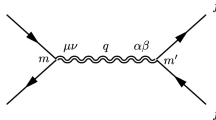Summary
The parity-non-conserving, V-A form of Fermi interaction is derived from a principle of invariance under a continuous group of transformations, in analogy with the ordinary gauge-invariance derivation of the minimal electromagnetic interaction of charged particles. This assumption is a stronger restriction on the form of Fermi interactions than that invoked bySudarshan andMarshak, Gell-Mann andFeynman, andSakurai, and leads to additional predictions that are subject to experimental check. If these transformations were symmetry transformations of the entire Lagrangian, then the β- and μ-decay coupling constants would be precisely equal. The implications of extending this Fermi gauge invariance to a group depending on space-time functions is discussed. The possibility that Fermi interactions involving change of strangeness are unallowed is considered, and the results of assuming a universal Yukawa V-A parity-non-conserving interaction are tabulated. Such a Yukawa interaction, involving one new coupling constant, leads to reasonable K-meson and hyperon decay rates and allows π-meson decay into μ+ν without any appreciable decay into e+ν.
Riassunto
La forma V-A dell’interazione di Fermi non conservante la parità si deriva da un principio d’invarianza rispetto a un gruppo continuo di trasformazioni in analogia colla derivazione ordinaria dell’invarianza di gauge della minima interazione elettromagnetica delle particelle cariche. Questa ipotesi è per la forma delle interazioni di Fermi una restrizione più severa di quella invocata daSudarshan eMarshak, Gell-Mann eFeynman, eSakurai e conduce ad ulteriori predizioni suscettibili di verifica sperimentale. Se queste trasformazioni fossero trasformazioni della simmetria dell’intera lagrangiana, le costanti di accoppiamento del decadimento β e μ sarebbero esattamente uguali. Si discutono le conseguenze derivanti dall’estensione di questa invarianza di gauge secondo Fermi a un gruppo dipendente da funzioni dello spazio-tempo. Si considera la possibilità che le interazioni di Fermi che comportino un cambiamento di stranezza siano proibite, e si tabulano i risultati derivanti dall’ipotesi di una interazione universale V-A di Yukawa non conservante la parità. Tale interazione di Yukawa, che richiede una nuova costante di accoppiamento conduce a ragionevoli tassi di decadimento dei mesoni K e degli iperoni e permette il decadimento dei mesoni π in μ + v senza apprezzabile decadimento in e + v.
Similar content being viewed by others
References
G. Puppi:Nuovo Cimento,5, 587 (1948);O. Klein:Nature,161, 897 (1948);T. D. Lee, M. Rosenbluth andC. N. Yang:Phys. Rev.,75, 905 (1949);J. Tiomno andJ. Wheeler:Rev. Mod. Phys.,21, 153 (1949).
E. C. G. Sudarshan andR. E. Marshak:Padua-Venice International Conference, September, 1957;Phys. Rev.,109, 1860 (1958).
R. P. Feynman andM. Gell-Mann:Phys. Rev.,109, 193 (1958).
J. J. Sakurai:Nuovo Cimento,7, 649 (1958).
M. Gell-Mann:Suppl. Nuovo Cimento,4, 848 (1956).
T. D. Lee andC. N. Yang:Phys. Rev.,108, 1611 (1957).
S. Bludman andA. Klein:Phys. Rev.,109, 559 (1958).
C. P. Sargent, M. Rinehart, L. M. Lederman, andK. G. Rogers:Phys. Rev.,99, 885 (1955);K. Crowe:Bull. Am. Phys. Soc., Ser. II,2, 206 (1957);L. Rosenson:Phys. Rev,.109, 958 (1958).
This observation is originally due toR. Gatto,UCRL: (private communication).
See the review byL. Michel:Rev. Mod. Phys.,29, 223 (1957).
R. Finkelstein andS. A. Moszkoswki:Phys. Rev.,95, 1695 (1954);S. S. Gerschtein andIa. B. Zel’dovich:Soviet Physics (JETP),2, 576 (1956);B. Stech:Zeits. f. Phys.,145, 319 (1956);M. Ross:Phys. Rev.,104, 1736 (1956).
SeeJ. Schwinger:Ann. Phys.,2, 407 (1957).
W. Heisenberg:Rev. Mod. Phys.,29, 269 (1957).
C. N. Yang andR. L. Mills:Phys. Rev.,96, 191 (1954).
S. A. Bludman:Phys. Rev.,100, 372 (1955).
Radiative corrections, which effectively lower the ϱ value, are being investigated for μ-decay through an intermediaryb field, in collaboration withH. S. Wong.
S. A. Bludman andM. A. Ruderman:Phys. Rev.,101, 910 (1956).Oneda and collaborators, inNuclear Physics,1, 445 (1956) and earlier papers, obtain a different rate for K → μ + v because, in the interaction (A1), they omit the factorM −1 which is different for π and for K decay.
M. L. Goldberger andS. B. Treiman:Phys. Rev.,110, 1178 (1958).
T. D. Lee andC. N. Yang:Phys. Rev.,108, 1645 (1957).
L. Stevenson:A.P.S. Stanford meeting, 1957.
W. H. Barkas: (UCRL) private communication.
The experimental transition rates into each mode are taken from the survey byM. Gell-Mann andA. H. Rosenfeld, Jr.:Ann. Rev. Nuclear Sci.,7, (1957).
J. J. Sakurai:Phys. Rev.,108, 491 (1957).
Author information
Authors and Affiliations
Additional information
Reported on at theNew York meeting of the American Physical Society, Jan. 29 1957;Bull. Am. Phys. Soc., Ser. II,3, 20 (1958).
This work was done under the auspices of the U.S. Atomic Energy Commission.
Rights and permissions
About this article
Cite this article
Bludman, S.A. On the universal fermi interaction. Nuovo Cim 9, 433–445 (1958). https://doi.org/10.1007/BF02725099
Received:
Published:
Issue Date:
DOI: https://doi.org/10.1007/BF02725099




